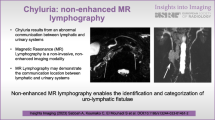Abstract
A 10-year-old boy with chyluria due to a congenital fistulous communication between the lymphatic system and the bladder is described. Chyluria can be parasitic or non-parasitic. Many causes of non-parasitic chyluria have been reported. Lymphography is the pre-operative imaging procedure of choice since it demonstrates the site, the calibre and the number of the fistulous communications. Lymphoscintigraphy shows very well the site of the fistula but is not as precise as lymphography. However, it has the advantage to be less invasive and is an excellent alternative in the non-surgical cases. The prognosis of non-parasitic chyluria is usually very good and the treatment is mostly conservative.
Similar content being viewed by others
References
Charters AD (1970) Filariasis in immigrants in Western Australia, including a case of chyluria recurring in seven pregnancies. Med J Aust 2:919–922
Cifferi F, Glovski M (1985) Chronic chyluria: a clinical study of 3 patients. J Urol 133:631–634
Cifferi F, Bakke AC, Lash A, Horwitz DA, Glovski M (1985) Immunologic studies in patients with chyluria. J Clin Immunol 5:307–313
Hashim SA, Roholt HB, Babayan VK, Van Itallie TB (1964) Treatment of chyluria and chylothorax with medium-chain triglyceride. N Engl J Med 270:756–761
Kutzmann AA (1925) Non-Parasitic chyluria. Ann Surg 82: 765–780
Lang ER, Redetzi JE, Brown RL (1972) Lymphangiographic demonstration of lymphaticocaliceal fistulas causing chyluria (filariasis). J Urol 108:321–324
Lloyd-Davies RW, Edwards JM, Kinmonth JB (1967) Chyluria. A report of five cases with particular reference to lymphography and direct surgery. Br J Urol 39:560–569
McMillan B (1967) Is filariasis endemic in the Nothern Territory of Australia? Med J Aust 2:243–244
Mogg RA, Jones JH (1971) Non-parasitic chyluria. Br J Urol 42:28–34
Okamoto K, Ohi Y (1983) Recent distribution and treatment of filarial chyluria in Japan. J Urol 129:64–67
Petit J, Sawczuk IS (1988) Use of lymphoscintigraphy in chyluria. Urology 32:427–431
Tuller MA, Feuer MM, Schapira HE HO P-P (1962) Recumbent chyluria. Am J Med 33:951–956
Yamauchi S (1945) Chyluria: clinical, laboratory and statistical study of 45 personnal cases observed in Hawaii. J Urol 54: 318–347
Yu HHY, Ngan H, Leong CH (1978) Chyluria — a 10-year follow-up. Br J Urol 133:126–133
Author information
Authors and Affiliations
Rights and permissions
About this article
Cite this article
Stalens, J.P., Falk, M., Howmann-Giles, R. et al. “Milky” urine—a child with chyluria. Eur J Pediatr 151, 61–62 (1992). https://doi.org/10.1007/BF02073895
Received:
Accepted:
Issue Date:
DOI: https://doi.org/10.1007/BF02073895




